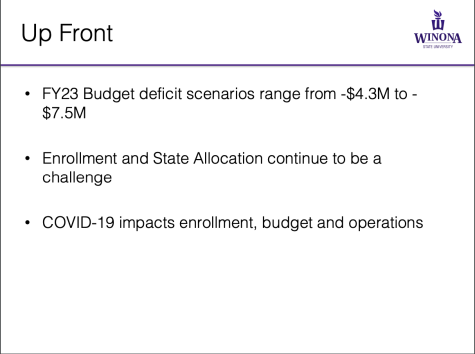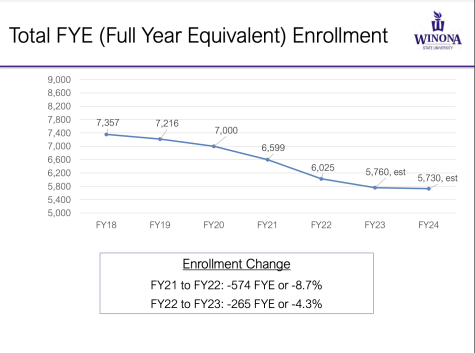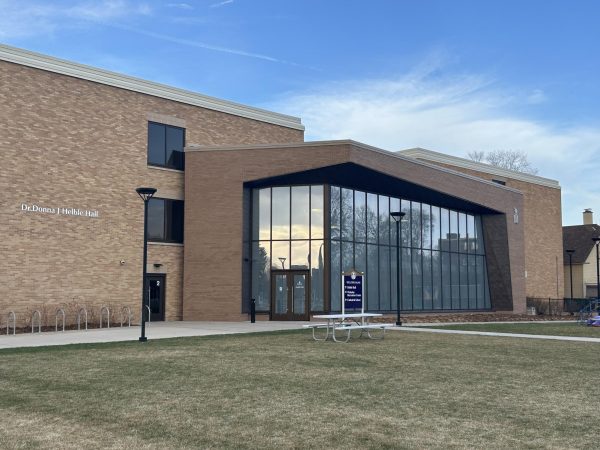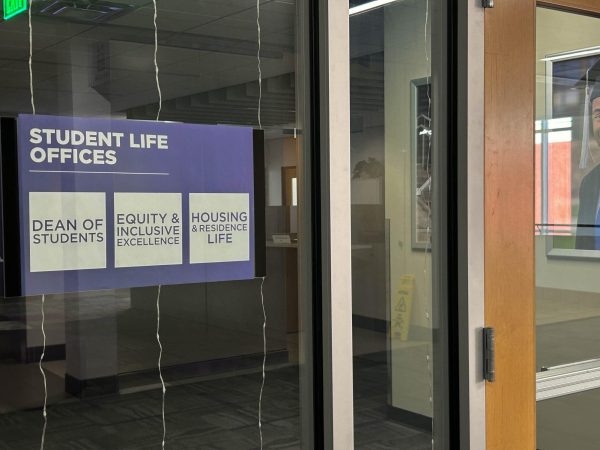Winona State updates ongoing budget deficit
Winona State University’s Main Campus pictured. The university’s budget deficit, first reported in the fall of 2016 by Winona State Student Senate, has steadily deepened each year since. A decrease in enrollment has remained a key factor in the deficit, but COVID-19’s economic effects continue to play a large role as well.
March 2, 2022
Winona State University’s latest budget deficit update on Feb. 9 highlighted difficulty in maintaining and increasing enrollment across Minnesota’s higher education institutions, discussion around BESI and potential raising of student worker minimum wage, among other topics.
The university’s budget deficit, first reported in the fall of 2016 by Winona State Student Senate, has steadily deepened each year since. A decrease in enrollment has remained a key factor in the deficit, but COVID-19’s economic effects continue to play a large role as well.
Initially, the deficit was reported to be between $2 and $3 million in the fall of 2015 with Vice President of Finance, Scott Ellinghuysen, having hoped the deficit would decrease to around $3 million by the fall of 2017. By the fall of 2020, with COVID in mind, the university had predicted a worst-case budget scenario of -$8.5 million for the 2020-21 year.
This past month on Wednesday, Feb. 9, Winona State’s latest open budget forum was held via Zoom and revealed the current worst-case budget scenario predicted for fiscal year (FY) 2023 has fallen to -$7.2 million.
Ellinghuysen shared the three budget deficit scenarios currently in place, simply titled “Best,” “Likely” and “Worst” scenarios: “Best” estimating a deficit of -$1.9 million; “Likely” estimating a deficit of -$4.5 million; “Worst” estimating a deficit of -$7.2 million.

Ellinghuysen announced current predictions and fiscal planning are being done based off the middle, or “Likely,” budget scenario of a -$4.5 million deficit.
“We are looking at a $4.5 mil- lion budget deficit next year in our general fund budget. That’s on a budget of about $90-$95 million approximately,” Ellinghuysen said.
“Budget reductions have been determined. We’re just a little bit short of our target, but we feel pretty good about it.”
Ellinghuysen also shared the state budget currently has a first-ever “large surplus” of $7.7 billion, which could mean some additional state funding for Winona State.
“The state of Minnesota… they have a surplus of $7.7 billion. Now, that’s on a state budget of approximately $54 billion–it’s the largest ever recorded. Typically, when the state has a surplus, it’s a billion, two million maybe at most. So, this is kind of uncharted waters,” Ellinghuysen said.
Although legislative sessions will be ongoing throughout the spring semester, Ellinghuysen said it is unlikely a dramatic lessening of the $7 billion surplus would occur. He estimated Winona State could receive about $1.5 million for their budget from the state in a best-case scenario.
“…we do have divided legislature, so it remains to be seen what happens through the process and if we receive any money from the state,” Ellinghuysen explained.
At the start of the budget forum, Winona State President Scott Olson noted schools throughout the MinnState system had been struggling with enrollment for years alongside Winona State, prior to COVID.
“The demographics, not just in Minnesota, not just in Southeast Minnesota where it’s particularly challenging, but the demographics nationally, have been very challenging. Families are smaller, people are having fewer kids,” Olson said. “So, we exist in a very challenging time in terms of demographics and on top of that, COVID caused lots of students to decide they maybe didn’t want to do higher ed.”

However, Olson also shared how proud he has been of the university’s efforts to keep the Winona State community safe during the pandemic. Olson and Ellinghuysen also discussed student minimum wage at on-campus jobs, which Student Senate has recently recommended Winona State increase. Currently, minimum wage for a student job is $10.33 while other schools in the MinnState system are offering upwards of $12.
Ellinghuysen said the topic of increasing student wages will be an ongoing conversation throughout this semester.
“So, [increasing campus minimum wage], you know, obviously is good for the students, they’re making more money, but it is just another pressure it puts on our budget,” Ellinghuysen said.
Currently, the university has received guidance from the MinnState system office to increase tuition about 3.5% for next school year. However, Winona State has also recently announced its plans to expand resident tuition to all students, meaning the potential 3.5% increase in tuition may not affect some students who will soon be saving thousands regardless with the expanded residential tuition.
Ellinghuysen highlighted the three primary impacts on the university’s budget: final legislative funding, tuition approval from the MinnState Board of Trustees and upcoming fall enrollment.
Final legislative funding will likely be confirmed in May 2022 and a tuition decision is expected in May or June of 2022.
One major budgetary tool Winona State has utilized several times now is the Board Separation Incentive Program (BESI), which was first offered in the spring of 2019. BESI is offered to specific, eligible employees as an incentive to enter early retirement, a move that allows the university to cut back on staffing costs without beginning layoffs or other tactics. Winona State offered the incentive again this school year. Ellinghuysens said roughly 115 faculty and staff were given the offer, resulting in 23 acceptances. Only three of the 23 individuals’ positions will be replaced.
“We have been in kind of a bud- get reduction mode for a few years here now,” Ellinghuysen said. “We are frequently asked, ‘Why wasn’t I designated for BESI?’ Well, the answer to that is you’re in a position that we would either have very little salary savings if it’s replaced or it would need to be replaced.”
He emphasized that utilizing BESI is a “budget balancing tool, not necessarily an employee benefit.”
With about 20% of the 115 offers having been accepted, it is a notable increase in acceptances compared
to previous BESI offers by Winona State, according to Ellinghuysen. He said the university will likely not offer the incentive again in the fall.
“I think we’ve offered [BESI] so many times that it might be losing its effectiveness,” Ellinghuysen said. “So overall, I guess I would say no, there’s no plans to offer it in the fall.”
“We’re the number one public university in Minnesota,” Olson said. “It’s a time absolutely of excellence, even as we are in a time of scarcity.”







































































